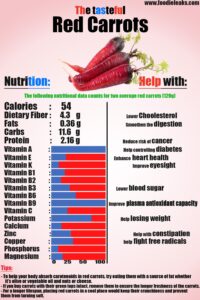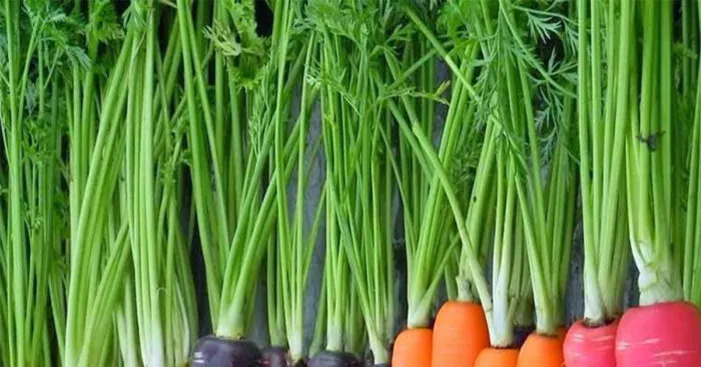
Red carrots, with their vibrant color and impressive array of health benefits, are truly a powerhouse vegetable.
Not only do they add a pop of color and delicious flavor to dishes around the world, but they also play a vital role in both the food and medical industries.
Pharmaceutical companies have long recognized the effectiveness of red carrot’s healing properties, utilizing it in a variety of medications.
Meanwhile, chefs and home cooks alike have been incorporating red carrots into their recipes for centuries, taking advantage of its unique taste and versatility.
But red carrots aren’t the only colorful variation of this beloved vegetable, as purple, yellow, and orange carrots also offer their own unique nutritional benefits.
So next time you’re looking to add some excitement to your plate, consider reaching for a red carrot – your taste buds and body will thank you!
Take anthocyanin, for example, it is the color pigment that gives most vegetables their color be it blue, purple, or red.
This color pigment is a type of flavonoid and it has antioxidant properties that can make a certain vegetable type healthier than the other.
In this article, we are going to focus on the nutritional data of red carrots, the health benefits of red carrots, how to make a homemade red carrots jam and the precautions you need to know before eating red carrots alongside some tips!
What are red carrots?

Red carrots owe their name to the coloring pigment “lycopene”. (3)
It is the same pigment responsible for the red color in watermelons, tomatoes, and several other vegetables and fruits.
Some people believe that red carrots first originated in Pakistan but others believe they are of Chinese and Indian origins. (4)
One thing we can agree on is that they came from the East.
Pickled red carrot was always popular in Middle Eastern culture.
It existed in recipes from the 12th century and is still used until today.
Europe and North America both started cultivating red carrots in the 15th century.
At that time, Western culture only knew orange carrots and it was shocking for them to see carrots in other colors.
Because of the red color and also because they both belong to the “root vegetable” category, red carrots are often confused with beetroot even though they differ in terms of shape, taste, uses, and nutritional value.
Compared to other types of carrots, red carrots contain a much higher content of vitamin C and A. (5)
This gives it an interesting antioxidant property linked to better resistance against several health issues.
Red carrots nutritional data:
Several scientific studies show that red carrots are a valuable source of nutrients.
Such natural compounds contribute to the well-being of our health.
Red carrots are full of dietary fibers and a high percentage of vitamins, the most abundant of which is vitamin A, vitamin C, and vitamin B1, B2, B3, and B6.
These nutritional data counts for two average red carrots (120g) : (6)

- Calories: 54
- Protein: 2.16g
- Fat: 036g
- Carbs: 11.6g
- Dietary fibers: 4.3g
- A vitamin: 206%
- E vitamin: 27%
- K vitamin: 14%
- B1 vitamin: 25%
- B2 vitamin: 18%
- B3 vitamin: 34%
- B6 vitamin: 45%
- B9 vitamin: 150%
- C vitamin: 30%
- Potassium: 74%
- Calcium: 19%
- Zinc: 36%
- Copper: 40%
- Phosphorus: 21%
- Magnesium: 13%
In addition to those, red carrots contain a wide range of minerals that our bodies need on a regular basis.
Among the red carrot minerals we mention the most abundant ones: Calcium, Magnesium, Iron, Phosphorus, Sodium, and Potassium.
Apart from all these nutrients, red carrots contain a very low-calorie content, so eating them will not cause weight gain in fact it may help lose weight!
Do you think that’s all that red carrots offer?
The color pigments and other components give red carrots a high efficient antioxidant property which promotes better health.
These antioxidants help to eliminate free radicals in the body, the main source of most diseases.
Carotenoids:
The main carotenoids in red carrots are Alpha and Beta carotene and lycopene.
Carotenoids are plant pigments that are mostly famous for their antioxidant properties.
They neutralize the body and make sure it is free from free radicals.
A diet full of carotenoid-rich foods shows lower risks of several diseases such as cancer, cardiovascular diseases, and diseases related to aging. (7)
Many carotenoids are precursors of vitamin A which means that the liver converts them into vitamin A.
Carotenoids can reduce the oxidative damage to DNA, therefore, reduce the risks of developing cancer.
Also, several studies confirmed that people who suffer from cystic fibrosis (The hereditary disease that attacks the digestive system and the lungs) has a lack of carotenoids in their blood. (8)
Other studies showed that taking beta-carotene supplements in cystic fibrosis patients improved their plasma antioxidant capacity.
More studies have to be conducted on cystic fibrosis patients to evaluate the effect of eating red carrots.
Fibers:
Certain types of fibers, in particular soluble fibers, can reduce the bad cholesterol in the blood.
A recent study showed that carrot juice had less effect on blood cholesterol compared to carrot consumption (which offers more fibers). (9)
Red carrots contain a lot of soluble fibers, in fact, an average red carrot weighs about 60g in which 3g are fibers mostly soluble.
In addition to its properties of reducing cholesterol, fibers can lower blood sugar levels by slowing the digestion process of sugar and starch.
Consuming red carrots regularly will provide the number of fibers your body needs.
It will result in maintaining intestinal health and a lower risk of constipation.
Red carrots health benefits:
Improves cardiovascular health:

These red carrots are full of fibers, antioxidants, and mostly potassium.
All of these nutrients contribute to the well-being of our heart because they help regulate blood pressure, reduce the level of bad cholesterol in the blood, and maintain a healthy weight.
Potassium for once, helps to relax blood vessels and thus reduces the risks of high blood pressure and other cardiovascular issues. (10)
Also, dietary fibers, once consumed, settle in the stomach and soak in water to turn into a gel form.
The gel-like form prevents the absorption of bad cholesterol by blocking the walls of the intestines and stomach.
Because of all of these beneficial nutrients, consuming red carrots will reduce the risk of developing cardiovascular diseases and contribute to the well-being of your heart.
May reduces the risk of cancer:

Rich in anthocyanins and carotenoids, red carrots are full of antioxidant properties.
Lycopene is also another nutrient found abundantly in red carrots.
This antioxidant substance helps reduce the risk of heart diseases and cancer. (11)
By eating red carrots your body will be stronger fighting and eliminating free radicals, the ones that lead to developing cancer.
Improves eyesight:

Red carrots are a good source of vitamin A, which has many functions in our bodies and mostly contributes to vision health.
A person with a lack of vitamin A usually is more vulnerable to night blindness.
Consuming food that is rich in vitamin A, such as red carrots will help compensate for the lack of vitamin A.
On the other hand, red carrots also offer a good amount of carotenoids which help our bodies reduce the risks of age-related macular degeneration. (12)
However, these vision improvements apply only to people who suffer from vitamin A deficiency and not everyone.
You should also take into consideration that according to the U.S. National Institutes of Health, vitamin A is the most deficient nutrient in the body with more than 1 billion people worldwide lacking vitamin A in their bodies. (13)
Helps losing weight:

Red carrots and carrots in general are very beneficial when it comes to dropping a few pounds.
While it’s best eaten raw, their juice is more effective at losing body fat. Red carrots are:
- A good source of dietary fibers and that means less feeling of hunger.
It is because dietary fibers go through the body undigested, they stop for a while in the stomach, then they flesh out all the toxins along the intestines and the colon.
During digestion, your stomach is full and that would last for a long time to give you a longer feeling of fullness. - Low in calories, so you will be getting a longer feeling of fullness with a low-calorie intake.
A cup of raw carrots (60g) contains only 50 calories and that represents only 2.5% of the daily calorie for a 2000 calorie diet. - Rich in vitamins and especially vitamin A.
This vitamin supports the metabolism of the whole body and is very beneficial for weight loss.
In addition to these virtues, red carrots are also super easy to combine with almost any dish as you can eat them raw, boiled, in a stew, made into a juice, or added to a salad.
Good for digestion:

An average red carrot usually contains about 1.8g of dietary fibers which makes about 7% of a person’s daily need.
On the other hand, a cup of chopped carrots provides about 4g of fibers and that’s 16% of the recommended daily need in fibers.
You may be asking, so what does that mean? How is that gonna benefit me?
High fiber foods improve intestinal health and therefore promote smoother digestion.
A recent study showed that people who follow a high-fiber diet are less likely to develop colon cancer.
Most people deal with digestive problems at least once a month whether it’s constipation, bloating, gas, or any other annoying issues… (14)
The fibers in red carrots will help your body deal better with constipation while protecting your intestines from harmful bacteria.
Making red carrot jam:

Ingredients:
- 2lbs of grated red carrots.
- 2 cups of sugar.
- 1 cup of concentrated lemon juice.
- 1 cup of water.
- 1 cinnamon stick.
- A tbsp lemon grated zest.
Steps:
- Put the grated red carrots in a bowl and add sugar, lemon grated zest, lemon juice, water, and the cinnamon stick then mix them all together.
- Settle the bowl in the refrigerator and keep it overnight
- The next day, heat the mixture over medium heat while mixing.
- Then, leave the mixture on low heat for 45 minutes and turn off the heat to let it cool down.
- Place the red carrots jam in a sealed glass container and place it in the fridge and enjoy a delicious homemade red carrots jam.
How to store red carrots?

The lifespan of carrots, in general, depends on the presence of their green tops.
If you are buying carrots with trimmed tops, you can store them for a good week on the lower shelf of the fridge.
Placing them in a cool place would keep their crunchiness and prevent them from turning soft.
If you buy carrots with their green tops intact, you should remove them. (15)
This is because the carrots are the roots of the plant, so they will keep trying to pump the energy to the tops to keep them green.
The result of that is the degradation of the roots in an attempt to keep the tops fresh.
Eventually, red carrots with their tops attached have a shorter lifespan and only stay fresh for two or three days.
Precautions before eating red carrots:

Red carrots are among the foods that can cause oral allergy syndrome.
This syndrome is an allergic reaction to certain proteins that comes from fruits, nuts, and vegetables.
Sometimes, it affects some people who already suffer from a pollen allergy.
For example, when these people are allergic to ragweed pollen and eat red carrots (or any carrots), several body reactions occur.
First, they’d feel itching and burning in the mouth, throat, and lips.
Cooking red carrots usually break down the allergic proteins. (16)
So in the absence of more serious symptoms, these people can carry on eating red carrots and don’t have to avoid them.
However, it is always better to see a doctor to furthermore assess if you need any special prescription.
Tip:
To help your body absorb carotenoids in red carrots, try eating them with a source of fat whether it’s olive or vegetable oil and nuts or cheese.
This is because carotenoids are fat-soluble compounds, therefore eating them with a source of fat will give your body easy access to carotenoids.
For the same purpose, cooked red carrots increase the absorption of carotenoids.
References:
(3): [Solved] What is the reason behind the red color of carrot ? (testbook.com)
(4): All about the Red Carrot – history and nutrition (carrotmuseum.co.uk)
(5): Red Vs Orange Carrot (Gajar) – Which is More Beneficial? – By Dr. Dinesh Bajpai | Lybrate
(6): Red Carrots Calories (59Cal/130g) and Nutrition Facts – Calorie Slism
(7): Carotenoids: Everything You Need to Know (healthline.com)
(8):https://www.medicalnewstoday.com/articles/147960#:~:text=Cystic%20fibrosis%20is%20a%20hereditary,%2Dthan%2Dnormal%20life%20span
(9): Is it Better to Drink Carrot Juice or Eat Whole Carrots? | livestrong
(10): Potassium lowers blood pressure – Harvard Health
(11): Lycopene: Benefits, Side Effects, and Interactions (verywellhealth.com)
(12): https://www.nhs.uk/conditions/age-related-macular-degeneration-amd/
(13):https://www.ncbi.nlm.nih.gov/pmc/articles/PMC3905635/#:~:text=Other%20estimates%20showed%201.02%20billion,body%20(4%2C5
(14): New Survey Reveals More than Half of Americans are Living with Gastrointestinal Symptoms and Not Seeking Care from a Doctor | AbbVie News Center
(15): How to Store Carrots – Best Ways to Keep Carrots Fresh & Last Longer (food52.com)
(16): Carrot allergy: Symptoms, diagnosis, and what to avoid (medicalnewstoday.com)
